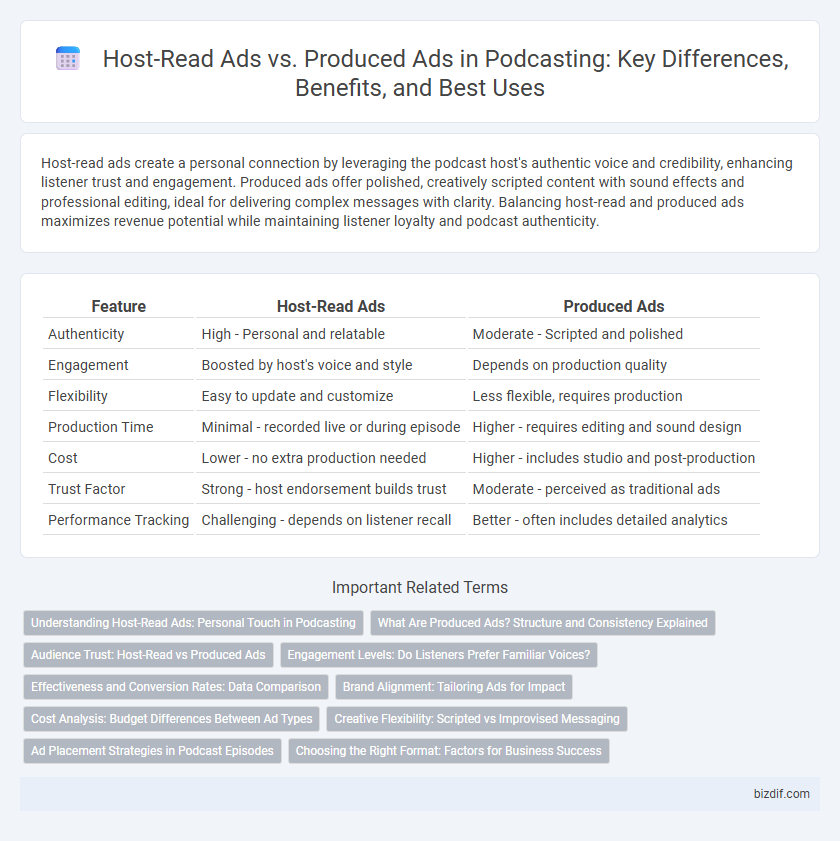Host-read ads create a personal connection by leveraging the podcast host's authentic voice and credibility, enhancing listener trust and engagement. Produced ads offer polished, creatively scripted content with sound effects and professional editing, ideal for delivering complex messages with clarity. Balancing host-read and produced ads maximizes revenue potential while maintaining listener loyalty and podcast authenticity.
Table of Comparison
| Feature | Host-Read Ads | Produced Ads |
|---|---|---|
| Authenticity | High - Personal and relatable | Moderate - Scripted and polished |
| Engagement | Boosted by host's voice and style | Depends on production quality |
| Flexibility | Easy to update and customize | Less flexible, requires production |
| Production Time | Minimal - recorded live or during episode | Higher - requires editing and sound design |
| Cost | Lower - no extra production needed | Higher - includes studio and post-production |
| Trust Factor | Strong - host endorsement builds trust | Moderate - perceived as traditional ads |
| Performance Tracking | Challenging - depends on listener recall | Better - often includes detailed analytics |
Understanding Host-Read Ads: Personal Touch in Podcasting
Host-read ads create a personal connection by leveraging the podcast host's authentic voice and style, which increases listener trust and engagement. Unlike produced ads, they seamlessly integrate into the content, making the advertisement feel like a natural recommendation rather than a scripted promotion. This personal touch results in higher conversion rates and stronger brand affinity among podcast audiences.
What Are Produced Ads? Structure and Consistency Explained
Produced ads in podcasting are pre-recorded commercials created with professional scripts, voice actors, and sound effects to ensure high-quality audio and polished delivery. These ads follow a structured format, often including a clear call-to-action and consistent branding elements to maintain listener engagement and brand recognition. Unlike host-read ads, produced ads offer greater control over message precision and creative consistency across multiple episodes and shows.
Audience Trust: Host-Read vs Produced Ads
Host-read ads generate higher audience trust due to their authentic, conversational delivery that leverages the podcast host's established credibility. Produced ads, often scripted and professionally polished, can feel less personal and may struggle to resonate emotionally with listeners. Listener engagement and conversion rates tend to be stronger with host-read ads because audiences perceive them as genuine endorsements rather than traditional advertisements.
Engagement Levels: Do Listeners Prefer Familiar Voices?
Host-read ads consistently generate higher engagement levels compared to produced ads due to listeners' preference for familiar voices that build trust and authenticity. Research shows that personalized delivery by podcast hosts enhances listener attention and ad recall, significantly increasing conversion rates. Brands leveraging host-read ads benefit from stronger emotional connections and greater audience retention throughout the advertising segment.
Effectiveness and Conversion Rates: Data Comparison
Host-read ads consistently demonstrate higher effectiveness and conversion rates compared to produced ads, with studies showing a 30-50% increase in listener engagement. The personalized delivery by podcast hosts fosters trust and authenticity, driving stronger call-to-action responses. Produced ads, while polished, often lack the intimate connection, resulting in lower conversion metrics across diverse podcast genres.
Brand Alignment: Tailoring Ads for Impact
Host-read ads offer authentic brand alignment by leveraging the host's trusted voice, fostering deeper listener engagement and credibility. Produced ads, while polished and consistent, may lack the personal touch that resonates emotionally with the audience. Tailoring ads to match the podcast's tone and listener expectations maximizes brand impact and campaign effectiveness.
Cost Analysis: Budget Differences Between Ad Types
Host-read ads typically demand lower production costs due to minimal editing and direct recording by the podcast host, making them more budget-friendly for smaller campaigns. Produced ads require substantial investment in scripting, voice talent, sound design, and post-production, increasing overall expenses but potentially delivering higher quality and engagement. Budget allocation often favors host-read ads for cost efficiency, while produced ads justify their higher costs through polished presentation and targeted messaging.
Creative Flexibility: Scripted vs Improvised Messaging
Host-read ads offer greater creative flexibility by allowing improvised messaging that feels authentic and personalized, enhancing listener trust and engagement. Produced ads rely on scripted content, ensuring consistency and polished delivery but may lack the spontaneous, relatable tone of host-read spots. Balancing scripted precision with host improvisation can optimize listener connection and brand impact in podcast advertising.
Ad Placement Strategies in Podcast Episodes
Host-read ads in podcast episodes create authentic engagement by leveraging the host's voice and trust, often placed mid-roll or during natural breaks for maximum listener attention. Produced ads, typically pre-recorded and professionally edited, enable precise timing and consistent messaging, commonly positioned as pre-roll or post-roll segments to capture audience before or after content. Strategic ad placement balances host-read credibility with produced ad clarity, optimizing revenue while maintaining listener experience.
Choosing the Right Format: Factors for Business Success
Choosing the right podcast ad format significantly impacts business success by balancing authenticity and production value. Host-read ads deliver personalized, engaging messages that build trust and listener loyalty, while produced ads offer polished, creative content suited for branding consistency. Evaluating target audience preferences, campaign goals, and budget constraints ensures selecting the optimal format to maximize ad effectiveness and ROI.
Host-read ads vs Produced ads Infographic

 bizdif.com
bizdif.com